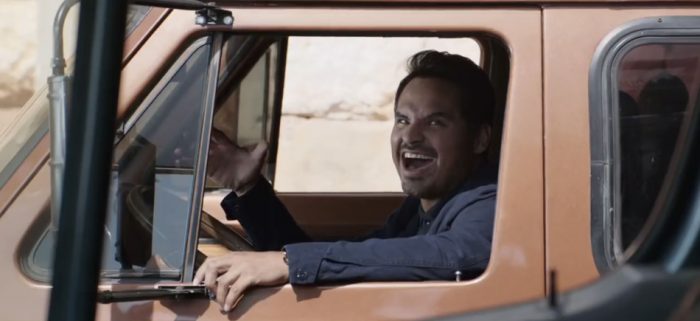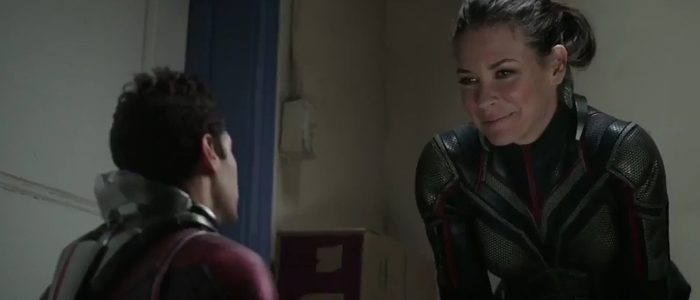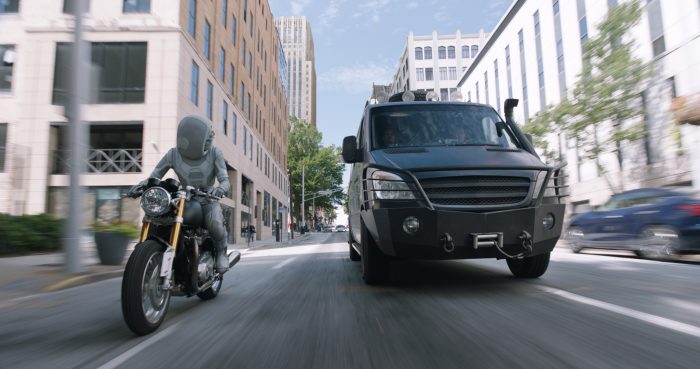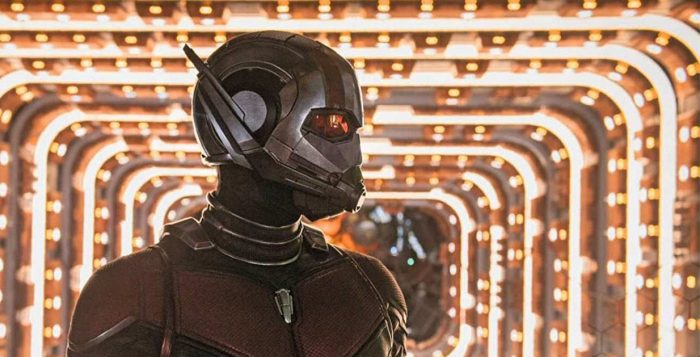'Ant-Man And The Wasp' Director Peyton Reed On The Quantum Realm, That San Fran Car Chase, And Mini Paul Rudd [Spoiler Interview]
From Ant-Man to Bring It On to his crowning achievement, Down With Love, there's a sincere buoyancy to director Peyton Reed's work. His deft control of tone is currently on display in Ant-Man and the Wasp, which brings good-hearted laughs to the Marvel Cinematic Universe after Infinity War's downer ending. While Reed made Scott Lang's (Paul Rudd) origin story a heist movie, the sequel is a comedy focused more on banter and character than action – though the action is bigger this time around.
Before making the latest entry in the MCU, Reed watched "the holy trinity of romantic comedies": Philadelphia Story, His Girl Friday, and It Happened One Night. "The male and female characters are so smart, and there's this mutual respect between those characters, particularly in His Girl Friday, they respect each other in terms of what they do," he told us. Reed, who's also fond of those movies' "incredible humanism," also discussed returning to the Quantum Realm, mini Paul Rudd, the end credits tags, the influence of Elmore Leonard, and more. Read our full Peyton Reed spoiler interview below.
Again, this interview contains spoilers for Ant-Man and the Wasp.
/Film: This hasn't been a great year for comedies, but walking out of Ant-Man and the Wasp, I thought it was just a really good comedy on a huge scale.
Peyton Reed: Oh, awesome. No, that's the thing, for Ant-Man and Wasp, Paul and I had this conversation that the first movie, half of the thing was he has never been an action hero before and is the audience gonna accept that. Now that they have embraced him in that role, in our movie and in Civil War, I told Paul, "I wanna make you funnier. You still gotta be the lead hero along with Evangeline, but let's just make it more overtly comedic." Part of that thing was the idea of the summer comedy, they were always like giant tentpole movies, but they're comedies and the fact that this could potentially be both, that was part of our sort of reason for making the movie.
Visually, how did you want to change the style up for the sequel?
Well, one of the big things we did at the beginning was the aspect ratio of the first one was 1:8:5 and we went 2:3:5 on this one, in part because when we talked about genre, the first one really keys up a heist movie. We wanted to stay in the crime genre here but we really started to look at stuff like Elmore Leonard crime novels. In the beginning, part of the thing was, what if Elmore Leonard wrote a science fiction novel and Marvel made a movie of it?
We knew that we wanted to have this very specific mission and we knew we wanted to create a situation where there were all these complications. Midnight Run and After Hours were two big movies that were very influential because it's a very simple goal, but there were all these people that come out of the woodwork, you know, street level criminals and more powerful antagonists, and then random situations where the plan gets screwed up constantly. I liked the energy of that.
Stuff like What's Up Doc? even, Bogdonavich movie, it was a big influence. We screened that at Marvel just for the comedy, the chase through San Francisco and the rapport between Ryan O'Neil and Barbra Streisand in that movie. I hired Dante Spinotti to shoot it 'cause he shot LA Confidential and all the Michael Mann stuff he did, I wanted to have this movie look amazing and do really widescreen compositions. We just sort of found ways to expand because he's so many different sizes in this movie – Ant-Man, Giant-Man and a few sizes in between – which was another big swing we took, which I love in the movie.
You knew you wanted to go more into the Quantum Realm after the first movie, but what were some of your other early ideas for the sequel?
We knew in the first movie we had set up a couple of things, one being the Quantum Realm, one was this sort of potential mystery of Janet when Scott Lang got out of the Quantum Realm. There was that moment in the first movie with Hank, you know, is it possible? And then obviously the Wasp, that was the thing, knowing that we wanna present her as a fully formed hero in this movie. After seeing an early cut of Civil War, that was the thing that sort of launched us into our structure. I think the Russos and Marcus and McFeely, when they brought in Ant-Man, Giant-Man into Civil War, probably didn't give a shit about how it affected our movie.
But the weird gift that they gave us was seeing that movie, my first reaction was, "This is Hank Pymm and Hope Van Dyne's worst nightmare. There's gotta be ramifications for the characters in our movie for Scott Lang's actions." So when we hit upon the fact that they were gonna be estranged at the beginning of the movie, and that Scott was gonna be on house arrest, and Hank and Hope would have to go underground because they were in violation of the Sokovia Accords because of their technology, that seemed interesting to us. It seemed particularly interesting to me for what it did to the Scott-Hope relationship.
While the movie is not a romantic comedy, there's a weird thing that struck me at some point I can't remember in the story, but I started thinking about Philadelphia Story and the fact that Cary Grant and Katharine Hepburn are divorced because of his drinking and she's now gonna get married to someone else. The whole arc of that movie is, what's gonna happen between these two? The audience wants them to be together, and that it's sort of predicated on Katharine Hepburn finding forgiveness for Cary Grant.
Though this is not that arc, there's some similarities just in the fact that Scott screwed up again and essentially betrayed Hank and Hope and meanwhile she's gone on to be a fully in charge, fully formed hero who really doesn't need a partner and now through circumstances, they're forced to work together again. It just felt like it really helped the spine of our story, the Scott-Hope arc.
 What made you want to do another one of Luis' story time sequences? Are they more complicated to shoot than they look?
What made you want to do another one of Luis' story time sequences? Are they more complicated to shoot than they look?
We talked a lot about, are we gonna do another one of those things? We loved them in the first movie, but we don't want it to feel like, "Hey, you all loved it from the first movie, let's do it again." We didn't want it to be self-congratulatory and weird, and we only wanted to do it if we could figure out a different take on it. At some point early on, I believe it was with Andrew Barrer and Gabriel Ferrari, two of the writers on the movie, we were talking about him giving a tip if it's crucial to the plot and they've gotta get some information.
One of them introduced the idea of truth serum, and I can't remember who it was, but when it came up, that was like, "That's it." If he's gotta be rambling and telling the story and maybe misconstrues the question and goes on a rambling tangent and he has to tell the truth, and in telling the truth he's gonna get not only Scott but Hope and Hank in trouble, that seemed dramatically cool and then allowed us to go nuts with the comedy. It also allowed us to very quickly, and in a really fun way, get a little bit of backstory about, "What went on between Scott and Hope between the first movie and this movie?"
It was also to do something different where it's not gonna be random people in Luis' life, but some of our main characters doing the lip syncing. So on those days we shot Peña doing it and paced him up, there must have been some amphetamines in the truth serum and I would go and do what I called a radio cut, take all of my preferred takes and string it together and then when it came time to shoot everybody's version, say if it's Evangeline's version, play the one line over and over and over so she can get the rhythm and cadence and just shoot the shot until we got performance and sync to where it really started to sing.
And it was really fun for them, but really frustrating, 'cause Michael's talking so fast and he's going "whatever whatever" and he's got that specific accent, so it was really hard at times, but I think they really enjoyed it.
Before he's injected with truth serum, there's one delivery of Louis' I really like where he responds very seriously to Walton Goggins' character, like, "I don't know anything about that." It's a cool crime movie moment where you're reminded he is a criminal, not just a goofball.
I'm glad that you noticed that. One of the big conversations that we had about Luis was, the first movie was all about those guys being ex-cons and trying to resist the urge to go back to a life of crime, and in this one, I really wanted the starting point to be, "Oh, they're small business owners now. They're trying to make a go of this business." There's that part of Luis, that you remember that he's a tough guy in addition to being a little goofy. He does feel a real sense of ownership of this company and a responsibility to the guys to make this company work. I like that we were able to create a movie where the success or failure of this ex-con company with Scott and Luis and the guys is as important to Scott as this mission into the Quantum Realm. It's fun to explore the dilemma being work life balance in one of these movies.
Those human stakes can feel as big as the stakes in an Avengers movie, too.
Yeah, it's obviously a much lighter movie in tone than Infinity War and there's not, I suppose, world shattering stakes, but to me, I like our stakes. I think our stakes are real human stakes. At the end of the movie when it's resolved and they finally land this client, not in the way they'd hoped to but in a different way, it should be every bit as triumphant as rescuing Janet from the Quantum Realm. I like that about the Ant-Man and Wasp tone.
 When Scott Lang is three-feet tall running around the school, was that a big visual effects challenge?
When Scott Lang is three-feet tall running around the school, was that a big visual effects challenge?
Weirdly for me, that was the single biggest effects challenge. Rudd and I were talking about that the other day that, in a movie that has a lot of visual effects and technical stuff in it, chases and Quantum Realm, shooting those few days at the elementary school with Paul being two-feet tall, then he's big in the janitor closet, and then three-feet tall, it was the most mind-numbing technical challenge of all. You wouldn't know it as an audience member seeing it, 'cause hopefully he kinda breezes by, but for visual effects to do the math it takes to shoot in a practical location and he's in shots with full-size Evangeline...it was torture to shoot that stuff. It was torture.
It shouldn't be, but it is. To get it realistic, cause it's all these...you're programming these shots in and they have to fit into them and he's moving through this space at two-feet tall, it has to feel like he's in a 3D environment. And then we had to at one point cram Paul in this miniature green screen janitor's closet with his neck bent, and it was weirdly painful. You'd think the car chase or something like that would have been the most mind-numbing experience, but it really was the school.
 With the car chase, you have a few moving pieces and cross-cut with Pym in the Quantum Realm, and they both flow and build up together very well. What was it like staging that sequence, visualizing it, and cutting it together?
With the car chase, you have a few moving pieces and cross-cut with Pym in the Quantum Realm, and they both flow and build up together very well. What was it like staging that sequence, visualizing it, and cutting it together?
I think the big thing that when we started early on in the process thinking, we'd done Ant-Man and shrinking and Giant-Man had appeared in Civil War, so how are we gonna top all that and keep the audience off guard and give them something new and surprise everybody? And we came up with the idea of two big things, I think: one was you know since he hasn't been Ant-Man and Hank has really been focusing on the Quantum tunnel technology, that maybe R&D on the Ant-Man suit has not been really a priority for Hank. So maybe the suit is not quite all there, the malfunctioning suit which gave us a chance to kind of like screw with Scott Lang's sizes, that was gonna be fun, but also let's apply this Pym Particle technology not just to people, but vehicles and buildings and just go nuts with that technology.
And then when we had the idea of the portable laboratory, how does someone get their hands on his tech in a way that's new and different and hopefully funny? When we looked at stuff like What's Up Doc?, which I saw when it first came out as a kid, the four different cases that get confused, it felt like a very Elmore Leonard-esque thing. Everyone's after the thing and now it changes hands and this and this.
It really started to dawn on us, if we could do a thing where they're shrinking and growing people and vehicles, and Ant-Man and Wasp and multiple people after this thing in San Francisco, and cross-cutting to Hank going in the Quantum Realm, that could just be a gonzo back half of the movie. It was insane from the beginning just storyboarding, doing pre-vis, and mapping that thing out. One of the great joys of this movie was having a lot more time to really spend time designing that stuff.
You mentioned cross cutting between a chase that takes place in broad daylight and a city we know and the Quantum Realm, and how can those two things fit together and not feel like you're going into an animated movie and a live-action thing? It really affected a lot of the way we visualized the Quantum Realm, really trying to make it grittier and introduce grain with Stef Ceretti, our visual effects supervisor, who is an actual genius. It was the idea of wanting some kind of look where it was really striking and colorful but also hard to photograph. Like the idea of the makers of Ant-Man and Wasp designed macro cameras that they actually went down in there and seeing the limitations of the photography that it's a little jittery and focus isn't always great 'cause it's so small. Building some of that stuff into the texture of Quantum Realm was something that we talked about and did a lot of R&D on. So yeah, it was a trick sort of having that be able to intercut seamlessly.
With Pym in the Quantum Realm, there's something about Michael Douglas suiting up and driving that vehicle that's very joyful, and seeing movie stars like himself and Michelle Pfeiffer in that environment.
One of the promises I made Michael for the second movie was, "Let's give Hank Pym a few more jokes and let's let Hank Pym see some action. Let's remind the audience that he was a big hero in the MCU in the past." I also love the idea of seeing him suit up, and I think it's one of the things I love about Ant-Man, it's one of the few MCU things where there's a mentor, there's a sort of generational approach to being a hero.
Yeah, when he was suiting up and down there, I loved it and I think he loved it. It reminded me of his dad, Kirk Douglas, maybe in 20,000 Leagues Under the Sea or something. There was something that really was striking about it. I knew Michael was enjoying it and having fun; he's not just sort of standing around in a lab coat talking about science. So that was exciting, and again, Michelle who had always been my dream casting even as far back as the first movie for Janet. The fact that she said yes, I mean I had no backup plan whatsoever. I was also surprised and thrilled to find that they had never done a movie together, I just assumed they had, but they hadn't.
So that was really fun shooting that stuff in the Quantum Realm. One, because it really is the emotional spine of the movie, the reunion between Hank and Janet and obviously Hope and Janet, so that was really thrilling. In terms of the Evangeline-Michelle Pfieffer thing, Evangeline just worships Michelle, and I think that you kind of see that in the performance a little bit when they're reunited. We're blessed with really amazing actors, but I wanted to make sure that I had the camera moves down, so that the first take we could get a really spontaneous reaction between them.
When Pym and Janet return from the Quantum Realm, there's that great colorful shot of Ant-Man reaching out for Hope, and all the action bursting in the frame is like a huge comic book panel. How did that shot come about?
One of the things way early on, pre-script, pre-story, was me just going back into those old Avengers and Ant-Man and Wasp comics where Hank was Giant-Man and she was Wasp, and you get a little in that janitor closet with a giant head next to a smaller head, but there had to be this give and take, this back and forth between Scott and Hope. Scott screws up and everybody's coming down on him and Hank and Hope get arrested and they've kinda given up on Scott, he shows up and rescues them from the FBI, then he becomes Giant-Man, and then she rescues him in the water and then he rescues her in the end – this back and forth.
It felt like at that point with the Quantum tunnel and coming out, reality was meeting this sort of theoretical quantum thing, and it wanted to be this big, the most colorful comic book moment in the movie. It was a really surprisingly tough shot to do, not only to get everything to time out properly, but we sort of fracture time and slow down. It is the most overtly comic panel and it wanted to feel in 2:3:5 like a big splash page.
 For the end credits tag, the first reaction I heard afterwards was "I hope Cassie's okay." Is she okay?
For the end credits tag, the first reaction I heard afterwards was "I hope Cassie's okay." Is she okay?
Well, we don't directly address that in the movie. There are answers to that, but I would get a Wasp tranquilizer dart in my neck if I revealed things. It's something that we all discussed ad nauseam, not only the writers and everyone involved in Ant-Man and the Wasp but also the Russos and Markus and McFeely because it's in the larger universe. There are things that are set in motion. So there are answers to that question and I can't reveal any of them.
How involved were the Russo Brothers in that sequence?
Well, I obviously directed that sequence. It was very interesting because we always knew we were coming out after Infinity War, and we knew we were gonna be a standalone movie, and we knew we were gonna be more directly dealing with fallout from Civil War. Throughout the writing process we were talking about, "At what point in our story do we really reveal where in the timeline are we with Infinity War?"
There were versions where it was maybe toward the end of the movie you're gonna see a TV in the background where this is happening. That just seemed lame to us, we've seen that before, that's not so interesting. Then at a certain point we landed on the structure which you saw, which felt like the very specific Ant-Man and Wasp way to deal with the events of Infinity War. I think it was probably Markus and McFeely, the writers, who came up with the general concept of what could and what was going to happen. But it was really up to us to figure out how it was gonna happen and to whom it was gonna happen, and so those guys were involved really in that thing, 'cause you know they're events that feed into the other movie, obviously.
But that was really fun because if we were gonna introduce Infinity War any earlier in our movie, it's such a massive event that happens at the end of that movie that it would threaten to just overtake our movie, which you just couldn't do dramatically, it didn't make sense. I think where we landed feels right in keeping in the tone of the movie, and we liked the arc of what it was gonna do to the audience. Also, you couldn't do something like the end of Infinity War again in our movie tonally, it would just be a repeat, so I feel like what we did was different and I think striking.
It's bleak for a comedy, but that last tag does end things on a laugh.
Exactly, it's a dark laugh, but it's a laugh.
***
Ant-Man and the Wasp is in theaters now.
